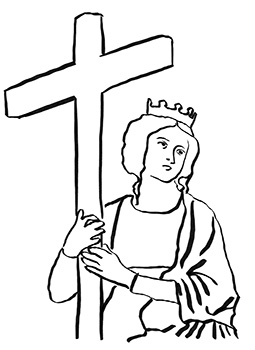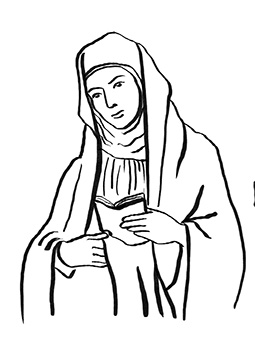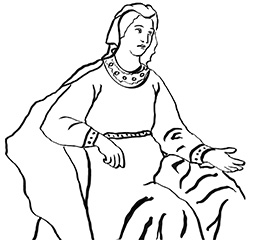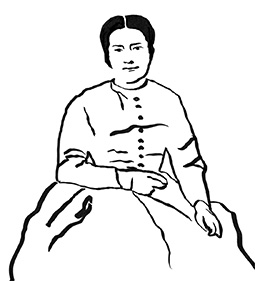“Look at the mothers who truly love their children: how many sacrifices they make for them. They are ready for everything, even to give their own blood so that their babies grow up good, healthy and strong,” said St. Gianna Beretta Molla.
Throughout Church history, we have many examples of mothers and the sacrifices they have made for their children. Some of them went on to become saints, while others have raised children who became saints. Here are several examples:
St. Helena, mother of Constantine the Great
 St. HelenaPhoto Credits: Illustration by Abigail WitteHelena (c. 250-330 AD) is thought to be from Drepanum (later known as Helenopolis) in Asia Minor. She married Constantius Chlorus. Their only son, Constantine, was born around 274. Nearly two decades later in 292, Constantius, now co-regent of the West, divorced Helena for another woman. It is believed he did this to advance reputation and standing in Roman society.
St. HelenaPhoto Credits: Illustration by Abigail WitteHelena (c. 250-330 AD) is thought to be from Drepanum (later known as Helenopolis) in Asia Minor. She married Constantius Chlorus. Their only son, Constantine, was born around 274. Nearly two decades later in 292, Constantius, now co-regent of the West, divorced Helena for another woman. It is believed he did this to advance reputation and standing in Roman society.
Constantine was loyal to his mother, whom he loved very much. Following the death of Constantius in 308, Constantine became emperor (Constantine the Great) and summoned his mother back into the inner circle and imperial court. Helena received the title of Augusta.
Constantine saw to it that his mother was to be honored. He had coins bearing her image minted. Through her son’s influence, Helena embraced Christianity. She was tasked with locating relics of Christian tradition. She began a pilgrimage to the Holy Land, is credited to have discovered the True Cross of Jesus and had a temple torn down and replaced with the Church of the Holy Sepulchre, where the cross is believed to have been discovered. Her feast day is Aug. 18 and she is considered the patron of new discoveries.
St. Monica, mother of St. Augustine
 St. MonicaPhoto Credits: Illustration by Abigail WitteBorn in Tagaste in northern Africa (present-day Algeria) around 332, she was given away in marriage to a pagan, Patricius. They had three children, yet their marriage was difficult, as he regularly abused her and was unfaithful toward her. Yet St. Monica prayed for him every day, and he was baptized a Christian one year before his death in 371.
St. MonicaPhoto Credits: Illustration by Abigail WitteBorn in Tagaste in northern Africa (present-day Algeria) around 332, she was given away in marriage to a pagan, Patricius. They had three children, yet their marriage was difficult, as he regularly abused her and was unfaithful toward her. Yet St. Monica prayed for him every day, and he was baptized a Christian one year before his death in 371.
But the most famous story of Monica and the power of prayer is dedicated to her son, St. Augustine, who became one of the most influential figures in the Church. Though Augustine was intellectually gifted, his young life was wayward, spending much of his time living promiscuously (he had a child out of wedlock), stealing and partying with friends.
This kind of life would be distressing to any mother, and Monica refused to give up on her son. She prayed daily and intensely for Augustine, fasted often and begged God to help him return to faith. When Augustine traveled to Rome and Milan for his education, Monica followed him, continuing her prayers for him.
While in Milan, Monica met Ambrose, the local bishop who later became a saint. He offered her spiritual guidance and noticed the long hours she spent praying for him. He promised her, “Surely the son of so many tears will not perish.” He was right.
Bishop Ambrose and Augustine became friends and had discussions about Christianity. As a result, St. Augustine finally was baptized at the age of 32.
Content at having witnessing her husband and son come back to the faith, St. Monica certainly saw the fruits of her prayer. She died in 387 Ostia Antica, Italy. Her feast day is celebrated Aug. 27.
Blanche of Castille, mother of Louis IX
 Blanche of CastillePhoto Credits: Illustration by Abigail WitteBlanche of Castille (born 1188, Castille, Spain; died Nov. 12, 1252, Paris) was the wife of King Louis VIII. Upon her husband’s death in 1226, she became regent for their 12-year-old-son, Louis IX, who was heir to the throne.
Blanche of CastillePhoto Credits: Illustration by Abigail WitteBlanche of Castille (born 1188, Castille, Spain; died Nov. 12, 1252, Paris) was the wife of King Louis VIII. Upon her husband’s death in 1226, she became regent for their 12-year-old-son, Louis IX, who was heir to the throne.
Blanche was an intelligent woman, described as a delicate diplomat, a clever negotiator and a strong leader. She not only thwarted a plot to kidnap Louis, but she also prevented violent rebellions and led armies into battle herself when it was deemed necessary.
As a mother, Blanche may have seemed overpowering in child-rearing. A devout Catholic, she instilled in Louis IX a love for worship and instructed him that devotion to God and the interests of his country were equally important. She also modeled for him the importance of charity and service to others.
She dedicated herself to her children’s education, but her primary concern was to impart a deep devotion to God and the Catholic faith. In his youth, Louis’ mother would tell him, “I love you my dear son, as much as a mother can love her child; but I would rather see you dead at my feet than that you should commit a mortal sin.”
At his coronation, King Louis IX made an oath to serve as God’s anointed, as the father of his people and feudal lord of the King of Peace. Louis interpreted his kingly duties in the light of faith. After the violence of two previous reigns, he sought to bring peace and justice to France.
During his reign, Louis was devoted to his people, founding hospitals, visiting the sick and, like his patron St. Francis, caring for people with leprosy. He united France — lords and townspeople, peasants and priests and knights — by the force of his personality and holiness. For many years, the nation was at peace.
Every day, Louis invited special guests from among the poor to eat with him, and a large number of the poor were served meals near his palace. During Advent and Lent, all who presented themselves were given a meal, and Louis often served them in person. He kept lists of needy people, whom he regularly relieved in every province of his dominion.
St. Zelie Martin
 St. Zelie MartinPhoto Credits: Illustration by Abigail WitteZélie Guerin was born into a military family in 1831 in France. She originally wanted to join a a monastery, but was unsuccessful, due to health issues. She turned to lace making, and become one of Alencon’s most talented lace makers.
St. Zelie MartinPhoto Credits: Illustration by Abigail WitteZélie Guerin was born into a military family in 1831 in France. She originally wanted to join a a monastery, but was unsuccessful, due to health issues. She turned to lace making, and become one of Alencon’s most talented lace makers.
Zélie met Louis Martin, a watchmaker, in Alencon, and on July 13, 1858, the two married. Within the next 15 years, Zelie and Martin had seven girls and two boys. Within three years, though, Zélie’s two baby boys, a five-year-old girl, and a six-and-a-half-week-old infant girl, died. Their five living daughters, Marie, Pauline, Leonie, Celine, and Marie-Francoise-Therese, became religious sisters. A century later people would come to know their youngest child as St. Therese of Lisieux, the “Little Flower.”
In a letter to her sister-in-law who had lost an infant son, Zélie wrote, “When I closed the eyes of my dear little children and buried them, I felt sorrow through and through … People said to me, ‘It would have been better never to have had them.’ I couldn’t stand such language. My children were not lost forever; life is short and full of miseries, and we shall find our little ones again up above.”
Zélie once said that, “Above all, during the months immediately preceding the birth of her child, the mother should keep close to God, of whom the infant she bears within her is the image, the handiwork, the gift and the child. She should be for her offspring, as it were, a temple, a sanctuary, an altar, a tabernacle. In short, her life should be, so to speak, the life of a living sacrament, a sacrament in act, burying herself in the bosom of that God who has so truly instituted it and hallowed it, so that there she may draw that energy, that enlightening, that natural and supernatural beauty which He wills, and wills precisely by her means, to impart to the child she bears and to be born of her.”
In 1877, Zélie died of breast cancer. She and her husband, Louis were canonized in 2015. Her feast day is July 12.
St. Gianna Beretta Molla
 St. Gianna Beretta MollaPhoto Credits: Illustration by Abigail WitteSt. Gianna Beretta Molla, born in 1922 in Italy, was an Italian physician, wife and mother. She was known for choosing a medical procedure to treat a uterine tumor that would minimize risk to the life of her unborn child, Gianna Emanuela. Gianna died in 1962, a week after giving birth.
St. Gianna Beretta MollaPhoto Credits: Illustration by Abigail WitteSt. Gianna Beretta Molla, born in 1922 in Italy, was an Italian physician, wife and mother. She was known for choosing a medical procedure to treat a uterine tumor that would minimize risk to the life of her unborn child, Gianna Emanuela. Gianna died in 1962, a week after giving birth.
Gianna dedicated herself to studies during the years of her secondary and university education, while also involved in apostolic service through Catholic Action and charitable work as a member of the St. Vincent de Paul Society. After earning degrees in medicine and surgery from the University of Pavia in 1949, she opened a medical clinic in Mesero (near Magenta) in 1950. She specialized in pediatrics at the University of Milan in 1952 and thereafter gave special attention to mothers, babies, the elderly and poor.
She became engaged to Pietro Molla and they were married in 1955 at the Basilica of St. Martin in Magenta. In their Ponte Nuovo home, Gianna gave birth to three of their children — Pierluigi, Maria Zita and Laura. While she was pregnant with her fourth child, a painful fibroma developed in her uterus. She chose a procedure that would not place her unborn child’s life at risk. She said, “If you must decide between me and the child, do not hesitate: choose the child — I insist on it. Save him.”
On April 28, 1962, she died at home of septic peritonitis after giving birth to daughter Gianna Emanuela at San Gerardo Hospital a week before. She was canonized in 2004 and is known as a patroness for couples experiencing infertility. Her feast day is April 28.
>> Pope John Paul II's Letter to Women
Thank you, women who are mothers! You have sheltered human beings within yourselves in a unique experience of joy and travail. This experience makes you become God’s own smile upon the newborn child, the one who guides your child’s first steps, who helps it to grow, and who is the anchor as the child makes its way along the journey of life.
“Thank you, women who are wives! You irrevocably join your future to that of your husbands, in a relationship of mutual giving, at the service of love and life.
Thank you, women who are daughters and women who are sisters! Into the heart of the family, and then of all society, you bring the richness of your sensitivity, your intuitiveness, your generosity and fidelity.
Thank you, women who work! You are present and active in every area of life — social, economic, cultural, artistic and political. In this way you make an indispensable contribution to the growth of a culture which unites reason and feeling, to a model of life ever open to the sense of “mystery,” to the establishment of economic and political structures ever more worthy of humanity.
Thank you, consecrated women! Following the example of the greatest of women, the Mother of Jesus Christ, the Incarnate Word, you open yourselves with obedience and fidelity to the gift of God’s love. You help the Church and all mankind to experience a “spousal” relationship to God, one which magnificently expresses the fellowship which God wishes to establish with his creatures.
Thank you, every woman, for the simple fact of being a woman! Through the insight which is so much a part of your womanhood you enrich the world’s understanding and help to make human relations more honest and authentic.”
Pope John Paul II, Letter to Women
To read the full letter, see www.vatican.va/content/john-paul-ii/en/letters/1995/documents/hf_jp-ii_let_29061995_women.html.